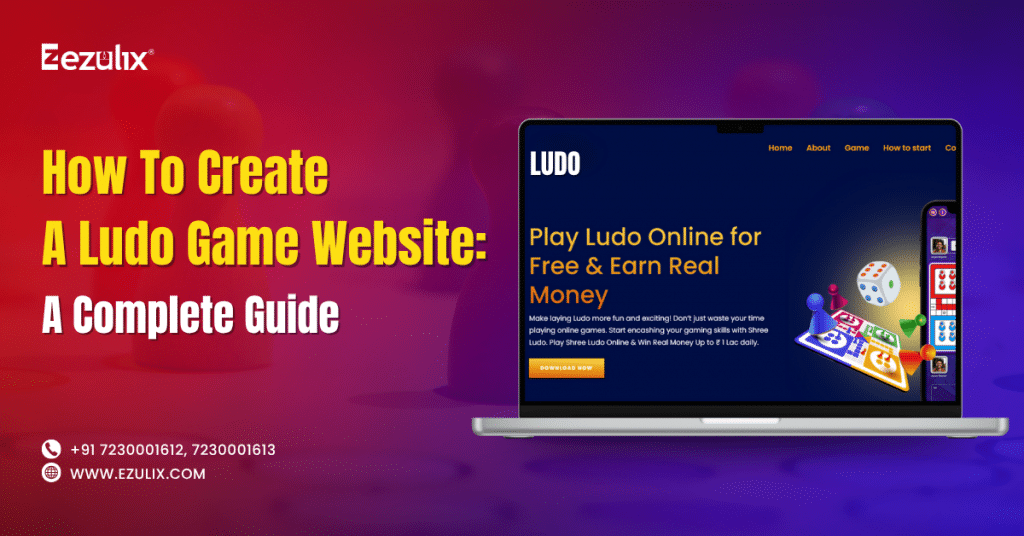Are you an entrepreneur and looking to enter the gaming industry? Then, investing in a reliable Ludo Game Development company is a wise move.
Ludo is one of the most preferred board games worldwide and is enjoyed by people of any age – from kids to adults, millennials to genZ. This classic saga can be played either online or offline across different platforms – Android, iOS, Windows, etc.
The unbeatable craze of Ludo among people encourages entrepreneurs or business owners to make an investment in Ludo game website development.
Are you also planning to experience the thrill of the gaming industry to earn lucrative profits? If yes, then relying on the experience and industry experts of Ludo game developers is crucial.
Here is a detailed description of how to build an engaging ludo game and what needs to be considered when choosing the right development partner to ensure success and longevity.
Table of Contents
Why Should You Create a Ludo Game Website?
Before diving into the technicalities, let us know why launching a Ludo game website is a brilliant idea:
- Ludo is one of the most popular and highly addictive games. It is easy to learn, attracting people of all age groups.
- Integration of the real-time multiplayer mode can help attract players, eventually building an active and strong gaming community.
- In-app purchases, advertisements, tournaments, and premium memberships can generate higher revenue.
Turn Your Ideation to Reality – A Step-By-Step Guide on How to Build a Ludo Game
Learn how to transform a ludo game idea into an engaging, fully functional, and profitable game business. The guide will walk you through everything you need to know to have a successful Ludo game launch. Without further ado, let’s get started!
Step 1: Conduct Market Research & Analysis to Form an Impactful Strategy
Before getting started with the development process, forming a precise and effective strategy is crucial.
Additionally, it is also essential to identify your target audience.
Do competitor analysis to determine core features and build robust strategies to drive growth and better engagement.
Last but not least, also pay attention to choosing the effective monetization model to generate revenue.
Step 2: Focus on App Design & Feature Set
Game design plays a vital role in boosting engagement and driving growth. Focus on intuitive and responsive game design.
In addition to this, determine what features your Ludo game will offer, like – online multiplayer mode, innovative bot feature for single player, chat feature, leaderboard, offline mode, in-game purchases, and private rooms.
Step 3: Choose the Right Technology Stack
The tech stack determines your Ludo game’s performance, security, and scalability. Therefore, opting for the right technology stack is crucial. Moreover, choosing the right Ludo game development company also significantly contributes to your game site’s success and growth.
Frontend: HTML5, JavaScript, Phaser.js, Vue.js
Backend: Node.js, Socket.io, MongoDB, or PostgreSQL
Cloud Hosting Tools: Vercel, Firebase or AWS
Other Utility Tools: OAuth, WebSockets, or JWT
Step 4: Coding and Game Development
The next step involves writing code, effortlessly integrating APIs, and ensuring impeccable gameplay. Develop the game logic, implement integrations, design the ludo board, and tokes using game libraries or HTML canvas. Apply game rules like entering the play area, winning parameters, dice roll logic, and rules for players. Make sure that the movement rules are precise and account for all edge cases.
Step 5: Design User Interface and Experience
Make sure to build a clean and intuitive UI that includes
- Game screen with player avatars, dice, chat, and the board
- Responsive layout for desktop and mobile
- Animations for token movement and dice rolls
- Sound effects and visual feedback for better engagement
Step 6: Testing
Testing is crucial to make sure that the website is bug-free and functions smoothly across different browsers or devices. To do so, consider:
- Playtest with friends to find bugs
- Use unit tests for game logic
- Ensure the server handles unexpected behaviour (e.g., sudden disconnection, abruption)
- Test responsiveness on different web browsers or platforms.
Step 7: Deployment
Once your Ludo game is built, tested, and development is complete, deploy your website. You can use:
- Netlify or Vercel for frontend hosting
- Render, AWS EC2, or Heroku for backend and WebSocket services
- MongoDB Atlas or Firebase for database hosting
- Additionally, add an SSL certificate and configure domains for secure access.
Step 8: Apply Monetization Strategies
Add ads, offer in-game purchases, referral or reward systems to attract users and boost engagement and growth. In addition to the Ludo game app development, consider promoting your site on social media, gaming forums, and app communities to attract players.
Step 9: Post-Launch Maintenance
Lastly, release regular updates for your game to stay ahead in the competitive market. This brings bug fixes, new features, functionality, performance improvements, robust security patches and more. Always prefer to focus on your user feedback and adapt to their needs to keep your player base engaged.
Ludo Game Development – Closing Words
Building a fully functional and responsive Ludo game website involves a unique combination of game logic, mechanics, creativity, and technical expertise. From game designing to handling the real-time multiplayer features, the process of Ludo game app development can be both profitable and daunting. However, with strategic planning, the right tech stack, and a focus on user experience, you can build a ludo game that connects players across the globe
758 total views, 1 views today
